LED Lights for Conspicuity and Visibility
Bright, low power consumption, lighting kit that improves visibility for the rider at night as well as visibility of the rider during the day.
The lights are a bit large and well suited for adventure and similar style motorcycles that have ample space and locations for mounting.
The importance of visibility to a motorcyclist cannot be overstated.
High-visibility riding gear and electronic devices such as headlight modulators can improve your visibility to other drivers and riders on the road.
At the same time, additional lighting can also improve visibility for the rider of the motorcycle in poor lighting when riding at night.
Adding auxiliary lights such as driving or fog lights can provide both “defensive” and “offensive” types of visibility.
How well the lights provide improved visibility and conspicuity depends greatly on the design of the light module(s) and the quality of the light they emit.
Quality of light is greatly affected by the type of light source and the reflectors and the shape and design of the reflectors used to direct the light.
The PIAA LP270 lights in this review use LED emitters for the source of their lighting.
For any of our readers not yet familiar with LED motorcycle lighting, let’s take a quick look at the technology, focused (!) on motorcycle use.
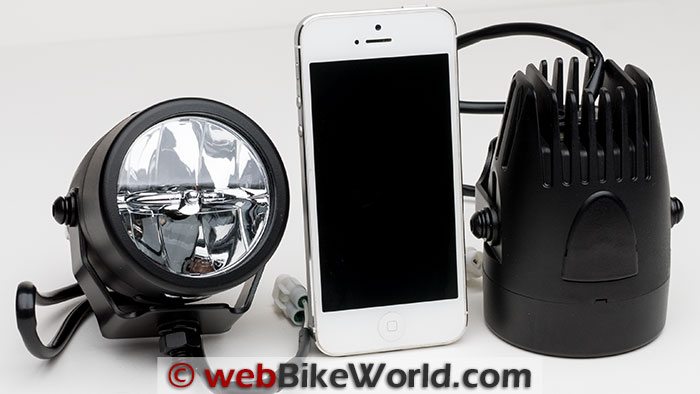
LED Lighting Basics
The technology used in automotive and motorcycle lighting has changed rapidly over the past several years, with LED (Light Emitting Diode) light sources becoming mainstream.
Most motorcycles do not have a lot of extra juice (amperage) in their charging systems, so LED lighting is well suited for motorcycle usage, thanks to its generally low power draw.
Also, LED lighting is a solid state technology, meaning that there are no mechanical or moving parts and no tungsten or other type of filament involved.
This makes LED lights very durable and resistant to vibration.
Incandescent lighting such as halogen or even HID (High Intensity Discharge) bulbs use filaments and/or gas contained in a glass “envelope” making them more delicate than LED type emitters.
For LEDs to be more widely adopted for usage in areas like headlights, the reflector must have a design that complement the unique output of an LED emitter.
The headlight reflector assembly in the typical motorcycle and even round “sealed beam” headlights is usually designed for an incandescent bulb, not an LED.
An LED emitter has a very different light dispersal pattern, which is one of the major reasons why an LED replacement bulb might not always perform as desired in a reflector or light system designed for a halogen bulb.
The resulting light output will often be weaker than expected and/or the light might not end up directed properly.
That’s why light housings like the design used for the PIAA LP270 LED driving lights may appear to be different from what we’re used to.
So with that said, let’s take a closer look at the popular PIAA LP270 lights.
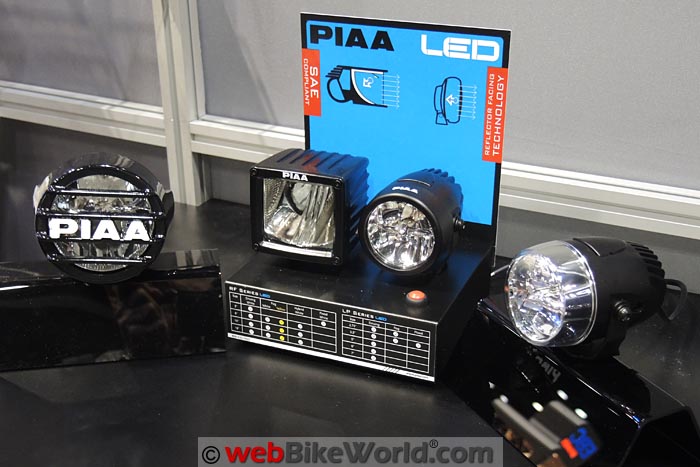
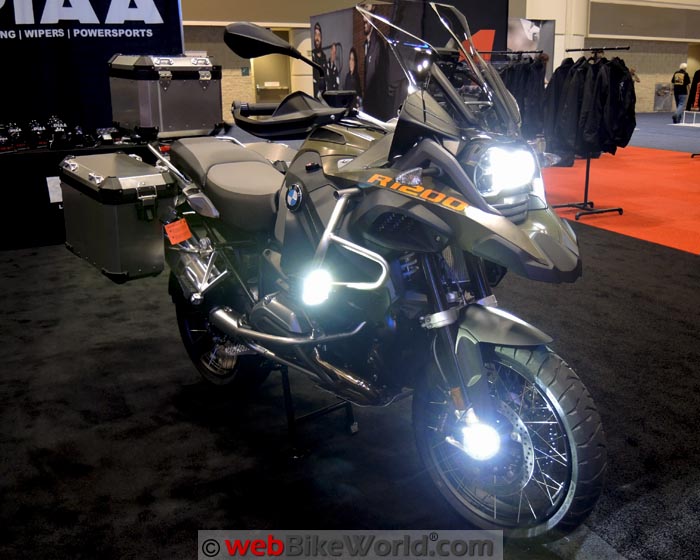
Where to Buy PIAA LP270 Light Kit
Check Reviews & Prices on Amazon Check Reviews & Prices On RevZillaAlso Shop for: LED Lights and Bulbs, Auxiliary Driving Lights, Motorcycle LED Headlights
The PIAA LP270 Driving Light Housings
I was getting ready to purchase a new set of lights for Carmen’s BMW R1100R. I already had a set of driving lights on my Triumph Sprint and felt these were fantastic addition to my motorcycle for increasing nighttime vision and daytime visibility.
After searching around, I ordered the PIAA LP270 2.75” LED Driving Light Kit. The PIAA LP270 lights are very popular and they come in two versions, the driving light version with an all-black housing and a fog light version with a chrome bezel.
The LP270 kit includes two 2.75” (70 mm) LED light assemblies, a wiring harness including a relay, inline fuse holder and switch. The light modules are rated to withstand 10G forces and the lights meet SAE standards. The light modules are IP67 tested for water and dust inclusion.
SAE Standards
For the U.S. states that conduct annual motor vehicle inspections, those vehicles (including motorcycles) must be compliant with all applicable laws and rules, and that includes lighting. Many (most) motorcycle auxiliary lights are not.
PIAA told us that the company has made a point to produce their products to be compliant with lighting laws while providing quality, performance and safety.
The reason for the focused beam patterns of the PIAA lights is to reduce glare and direct the beam to exactly where the rider adjusts it.
They also said that this is a unique approach in the LP- and RF-Series light kits that should be a consideration at the time of purchase.
In the Kit
Opening the box revealed lights that are a bit larger than I expected. Each light housing does indeed measure 2.75 inches (70 mm) in diameter and they are 3.8 inches (98 mm) deep.
The rear third of the housing tapers down in diameter to about 2 inches (48 mm) and the rear of the light has thick cooling fin cutouts (12 total).
The LP270 light housings are black and made from a cast aluminum casing with polycarbonate (plastic) used for the lens. Weighing in at 340 grams (12 oz.) each, the light housings have a very solid feel.
Attached to the back of each light housing is a permanently connected cable with a generous amount of water-sealing silicone around the entry point for waterproofing.
The cable on each light terminates in a quick connector that attaches to the included wiring harness. The harness itself is rather long and should easily be able to cover distances across most any motorcycle frame one would encounter.
A push button switch rounds out the included components; it also plugs into the harness.
PIAA also includes a hex wrench, zip ties, and a Scotchlock-type wire splicer for finalizing the installation. The included hex wrench is to adjust and reposition the brackets on the light housing if needed (more on that shortly).
The brackets on the light housings allow for a few degrees of vertical or horizontal adjustment, depending on how the lights are mounted.
The brackets are finished in black like the rest of the light housing.
Overall, the kit is very well put together and all the connectors between the various items and the wiring harness fit easily and securely. With that said, let’s see how it all comes together installing on a motorcycle.
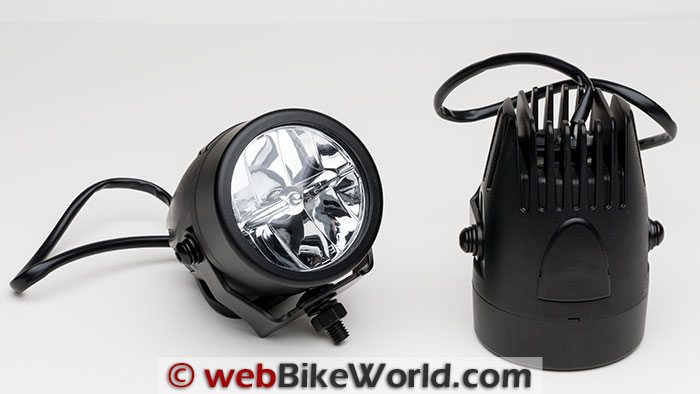
Mounting Locations?
Our test bike for the PIAA LP270 lights is a 1995 BMW R 1100 R, a Telelever BMW boxer from the beginning of the “Oilhead” era.
This bike doesn’t offer a lot of options for mounting auxiliary lights, but I was certain I could find a location. But, this proved a bit more difficult that I thought.
My original plan of attack was to mount the lights using the fender mounting bolts on the fork legs. This location has served me well on my Triumph Sprint for a pair of MondoMotos LED driving lights I installed.
Those lights are much smaller and lighter than the LP270 lights however and holding one of the PIAA lights in hand and looking at the rather small (thin) bolt used for the fender mount on the BMW, I decided this was not going to work.
I would like to point out that PIAA does offer a kit of bolts and spacers designed to work on over 80 different motorcycle models. The BMW R 1100 R was not on that list however, so this is why extra time and effort was necessary to get these lights mounted.
The next logical spot would be to mount the PIAA lights to the fork legs, which would require an additional mounting bracket.
This presented its own challenge, as the Telelever fork legs are not actually round on this era BMW, believe it or not, but oval. This irregular shape made it difficult to find the necessary 2.125″ inch (53 mm) bracket that would work to attach the lights.
PIAA offers some brackets that would likely fit but they were relatively pricey at around $70.00 (USD) and these still might not fit the oddly shaped BMW fork legs.
At one point, I handed the lights over to a friend with a 2000 BMW R 1100 RT to see if he could install the lights on that bike. We both thought there might be a suitable mounting option, but again, we failed to find a spot that would work.
The issues were the size and weight of the LP270 lights in each case.
Note that for a motorcycle with tubular engine guards, the mounting issue would have been easy to remedy.
Bottom line? I suggest that the PIAA LP270 lights should be installed on a motorcycle with plenty of room for accessory lights. For example, most adventure-touring bikes, which usually have tubular engine guards, would be good candidates for the LP270 lights.
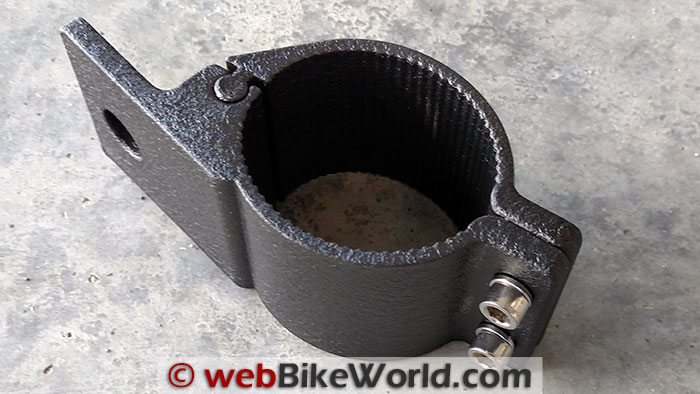
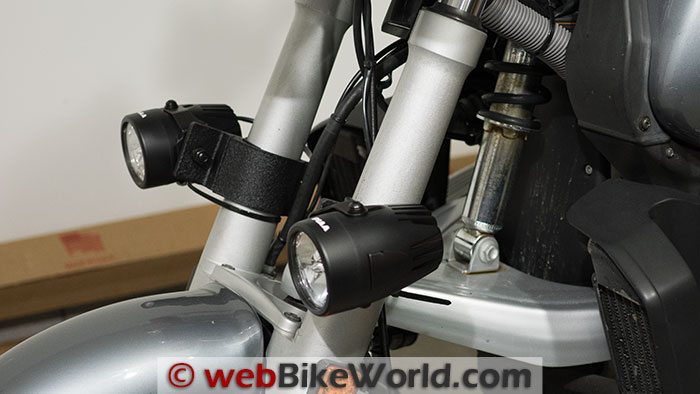
Mounting Bracket Problem Solved
Not being one to give up — and also trying to keep the spending on mounting hardware to a minimum — I found this set of brackets on Amazon.com for $25.99.
These brackets are formed from two halves that when pieced together are on the smaller end of the 49-55 mm range and they actually form a slight oval instead of being perfectly round (photo above).
These brackets ended up working better than I could have hoped for. They fit snugly on the BMW’s fork legs and they are robust enough to handle the weight of the PIAA light housings. They also look good with the lights mounted on them.
I’ve been told by several people who have seen them that they look as if they were made for this application.
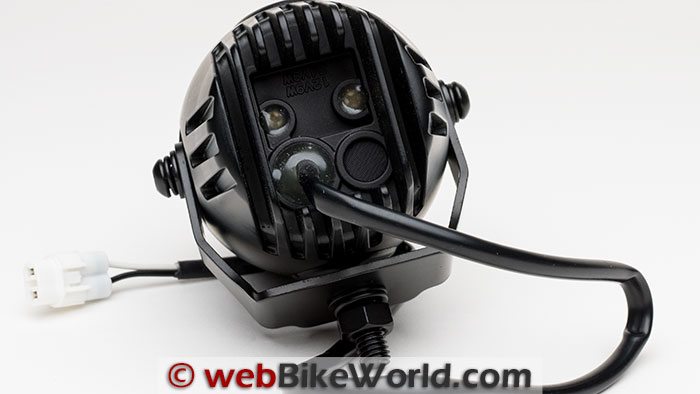
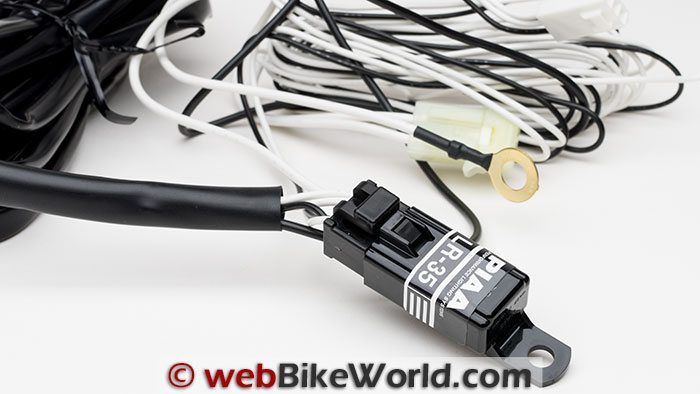
Where to Buy PIAA LP270 Light Kit
Check Reviews & Prices on Amazon Check Reviews & Prices On RevZillaAlso Shop for: LED Lights and Bulbs, Auxiliary Driving Lights, Motorcycle LED Headlights
Wiring the Lights
With a suitable location found for the lights, it was time to wire up the system.
The included wiring harness and attached connectors make it easy and fool proof to get everything connected. But getting all the wiring located so it would be inconspicuous presented more of a challenge than the rest of the wiring process in this case.
The wiring harness is very long, which is good as it will accommodate a wide variety of motorcycles. The downside is dealing with all the excess cable.
Normally, I would simply cut and re-splice the wiring in questions to make it a more custom fit. But for this review, however, I wanted to install the lights without making any wiring modifications.
Connections were easy to make. Ring terminals are provided for connection to the battery and a single wire without a connector (for use with the included splicer) is present for connecting to a switched power source. This is used to make the lights turn off with the bike’s ignition switch.
The on-off switch for the lights and the wiring for the light modules connect into the harness with disconnects and they are very easy to work with.
Something to note is that if you want the lights to be available when the ignition is off, a bit of modification to the wiring will need to be done.
The included switch has an LED that glows green when the ignition power comes on and glows red when the lights are on (seems like it should be the other way around, but this same system is used in the Clearwater lights we reviewed).
If you want to use a constant power lead (unswitched), the lights will work via the switch, but the LED on the switch will continue to stay on even when the lights and ignition are off. Over time this could run down the battery far enough to keep the bike from starting.
Installing the on/off switch itself is rather straightforward using the included double-sided adhesive pad. In the case of the R 1100 R, I didn’t like running the wire from the bottom/rear side of the triple clamp, so instead I placed the light switch upside-down on the top of the triple clamp (see photo).
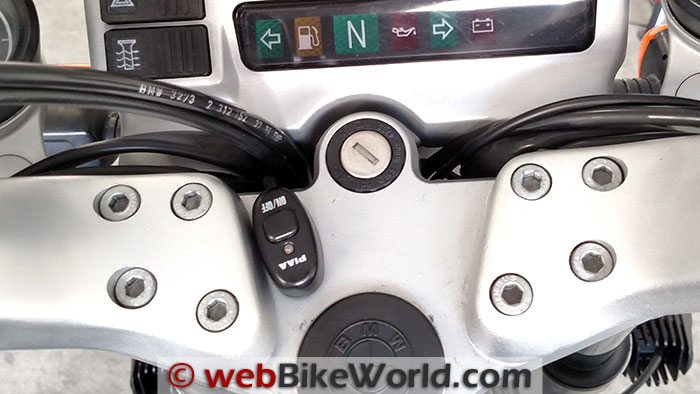
Light Module Orientation
Now that the lights were wired, I had to test them to be sure they worked, which they did. However, as I shined the lights onto the wall, I noticed that the beam was rather tall and narrow.
Turns out the beam pattern of the LP270 lights is directional and this explains the extra two plastic covers on the housing.
By default, the brackets are attached to the lights in a fashion designed for mounting the light onto a bar above or below the housing. In the manner I had them attached it became necessary to rotate the brackets so the lights remained in the correct orientation.
This is done by removing the plastic inserts on the housing to reveal two more mounting holes.
This is easy enough to do but the lights are rather a snug fit in the brackets and I ended up putting small scratches in the finish when prying them out of place.
Once the lights were re-oriented, the beam pattern made more sense.
Overall, the installation process was pretty easy to perform but it does take time to make the wiring harness runs nice and neat.
For those interested in doing their own wiring, there is plenty of excess in the wires for trimming and to create a custom setup for different switches or removal of the relay if they already have their own switched power supply option.
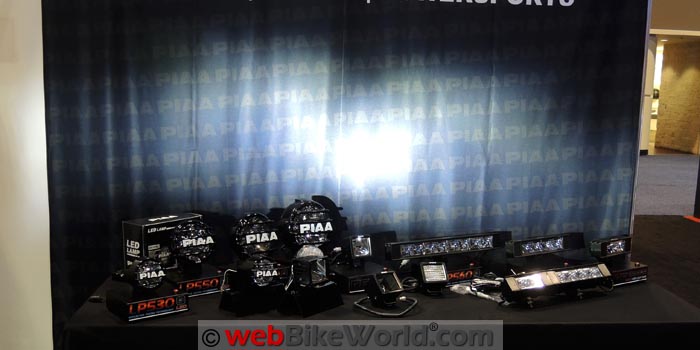
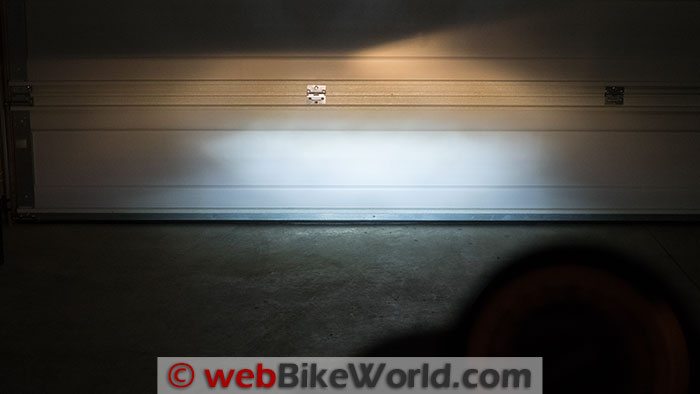
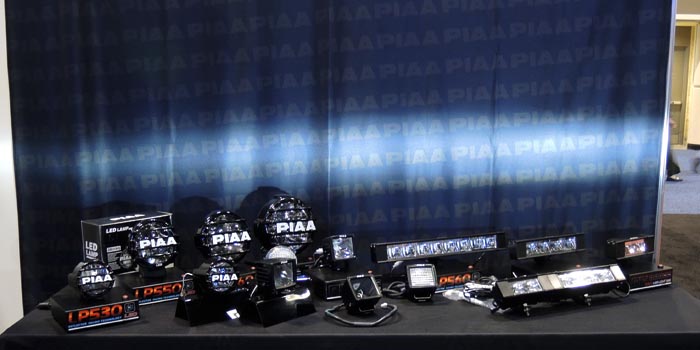
PIAA LP270 Light Performance and Beam Pattern
The LP270 driving lights are bright! Each LP270 driving light has two LEDs rated at a total of 9.3 Watts.
By the way, the Driving Lamp Kit is PIAA part number 73272 (Black Lens Bezel) and the Fog Lamp Kit is part number 73270 (Chrome Lens Bezel).
The LP270 fog lamps also have two LEDs, rated at a total of 7.5 Watts. The LEDs in both light types face up and down and are the reflected type (see description below). Both lights are designed to meet SAE standards.
The LP270 driving light pair is easily brighter than the 55 watt stock headlight on the BMW R 1100 R with approximately 15% less wattage.
I measured the output of the LP270 lights at 3 meters with a handheld photographic light meter. It read 12 EV (exposure value) at ASA 100, which translates to 10,240 lux. So there are some technical numbers, but trying to tie significance to them can be difficult.
Relative comparison, however, can help. I compared these numbers to the set of MondoMoto MM 10 watt LED driving lights on my Triumph Sprint. Those lights output just over 8EV, but to the eye they look only a little less bright.
This comes back to the quality of light I mentioned earlier. The reflectors that shape the beam can make a huge difference in output and beam shape.
The smaller MondoMoto lights with their diffused lenses spread the light out more, making them less bright at a distance, but they throw a larger circle of light.
The clear lenses and reflector design on the PIAA LP270 driving lights throw a tighter and therefore brighter beam, within their smaller circle (rectangle?) of light.
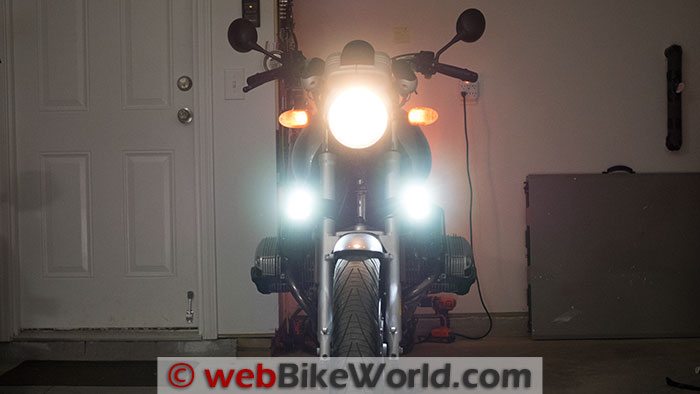
More on the LP270 Lights
Besides the rugged build quality, the LP270 lights use what PIAA calls the “Reflective Facing Technology (RFT)”. It’s a unique rearward-facing bulb design.
PIAA says that the design “significantly improved lighting and beam control compared to conventional LED and halogen lamps with forward-facing bulbs.”
They also said that the reflectors are computer designed with multiple surface curvatures and patterns “to help focus the beam pattern of the rearward-facing LED bulbs more precisely than forward-facing LED lamps.
The PIAA Reflective Facing Technology is included with the LP series lights and their RF series square housing LED lights.
The LP270 fog lights output a thin, wide band of light, while the LP270 driving lights have more of a focused hybrid spot light. Both lights have upward and rearward facing LEDs, two in each light housing, for a total of 7.5 Watts for the fog lights and 9.3 Watts for the driving lights.
PIAA told us that their lights are capable of more power but the electronics are designed to help increase longevity of the LEDs.
Where to Buy PIAA LP270 Light Kit
Check Reviews & Prices on Amazon Check Reviews & Prices On RevZillaAlso Shop for: LED Lights and Bulbs, Auxiliary Driving Lights, Motorcycle LED Headlights
Color Temperature
Color temperature of the light output can also improve visibility. Bright white light makes it easier for our eyes to make out details and to better interpret the colors of objects.
PIAA claims these lights put out a 6000K light (the type of “white/blue” light seen approximately at noon on a sunny day).
Testing against my color chart using the middle gray patch showed they are actually a bit higher at about 6600K. This is closer to the light one sees on an overcast day. No matter, the light is viewed as white to the eye with only a slight blue-ish tint.
The increased distance of visibility and overall brightness can be seen in the two photos in the slide show above.
The pile of sand visible in the pictures is about 65 feet away from the front of the bike. The camera was set to manual so the brightness (and color) difference and visibility of objects in the distance is representative of what I saw with my eyes.
So for increasing visibility for the rider, the LP270 lights definitely improve what you can see at night. Depending on how the beam is directed — higher or lower — the reach of the lights can extend vision much further down the road ahead.
What about making the bike more visible to others during the day?
While the tightly focused beam, combined with the clear lenses, makes excellent illumination for what’s ahead, they also reduce the noticeability of the lights when viewed from outside the axis of the direct beam.
This is not really unexpected and actually not a bad thing — you don’t want to dazzle oncoming traffic. There has to be a tradeoff and this is it.
Certainly vehicles approaching from the other direction will see two additional bright spots on the front of the bike, but a diffused reflector will create two very intense points. The result would be less forward throw and thus will reduce the effective range of the lights.
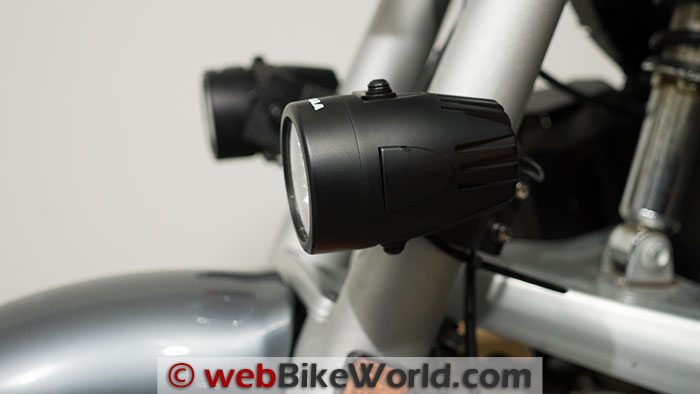
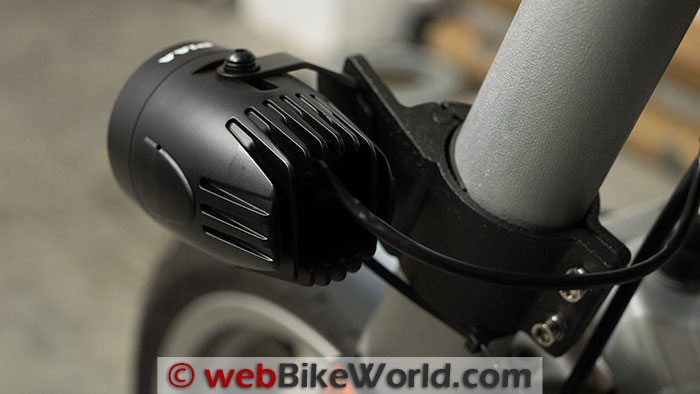
Conclusion
The PIAA LP270 driving light kit is a sturdy and well-engineered design. The hardware and the wiring are all quality pieces of kit and should last a long time.
Light output is very impressive for the power required to run these lights and the reflector design makes the most of this light.
The intense and clean light output makes these ideal for any rider who travels at night, be it an adventure rider on gravel road or on the interstate highway.
Mounting options need to be considered, as the light modules are relatively large and they need a secure mounting point. A motorcycle with an engine guard or other add-on rails is a prime candidate.
If your bike happens to be on the PIAA list of available mounting kits, this will save time and work in the installation phase.
Overall, the PIAA LP270 lights are very good for improving the view in lower light / nighttime conditions.
As far as improving conspicuity during the day, the lights are good, but possibly a light with a more diffuse lens might be spotted more easily. Note, however, that the LP270 lights are not designed as conspicuity lights.
The $349.00 (USD) list price (~$289.00 street price) keep them from being called a bargain, but if they last as long as their build quality suggests, the price seems appropriate.
Where to Buy PIAA LP270 Light Kit
Check Reviews & Prices on Amazon Check Reviews & Prices On RevZillaAlso Shop for: LED Lights and Bulbs, Auxiliary Driving Lights, Motorcycle LED Headlights
Owner Comments and Feedback
See details on submitting comments.



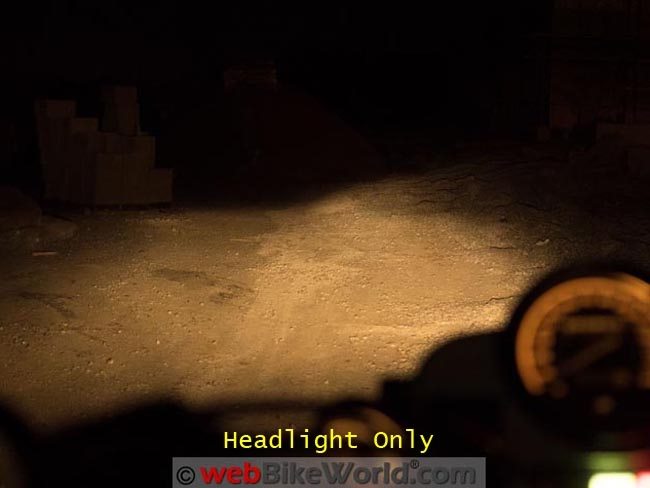
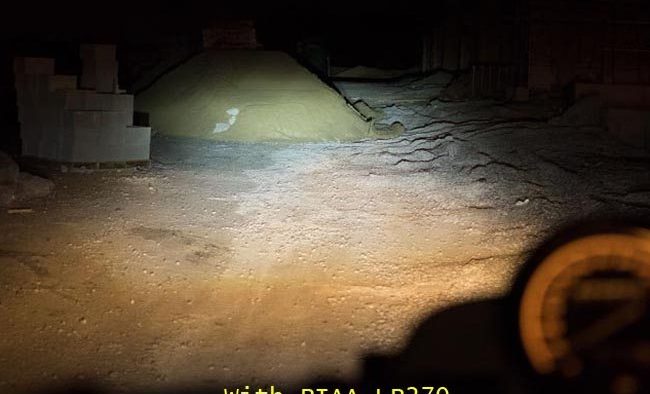

No Comment